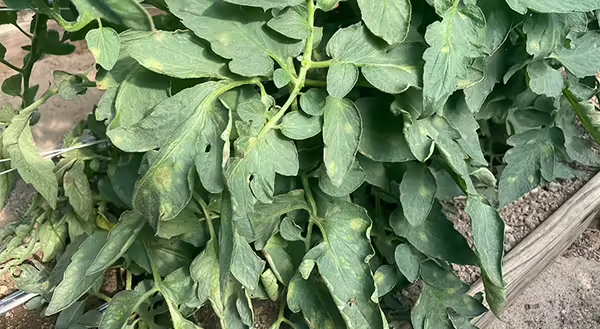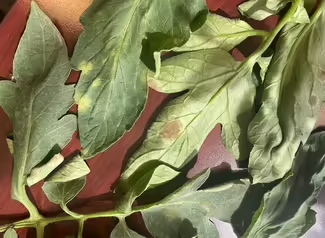
Over the last few years of growing tomatoes in the high tunnels in southern Illinois at the Dixon Springs Agricultural Center, leaf mold has been observed late in the growing season, typically towards the end of August. At that time of year almost all of the tomato fruit has been harvested and there has been no reason to make any fungicide applications. Each of our tunnels has HAF (horizontal airflow) fans that help to circulate air and the side curtains are opened almost fully every day. But this season, leaf mold was found in the first week of June. The plants showed pale yellow splotches on the tops of the leaves along with grayish brown spots on the underside of the leaves that matched up to the topside splotches.
With two of our high tunnels planted with basically the same number of plants, it was interesting to see that one tunnel seemed to have more disease pressure than the other. The tunnel with more leaf mold pressure has solid polycarbonate endwalls and the side curtains drop down to open. It would make sense that this tunnel has less overall airflow compared to the other tunnel with endwall openings of 20ft by 8ft and side curtains that roll up to open.
Cornell University has two different sources of information, Leaf Mold in high tunnel tomatoes and Tomato Leaf Mold, that provide information on the fungal pathogen, life cycle, symptoms, and prevention and control suggestions. In reading through these sources, it was mentioned that some cultivars have resistance to leaf mold. We have five different tomato cultivars planted in the high tunnels and the following four cultivars have leaf mold symptoms: ‘Mt. Gem’, ‘BHN 589’, ‘BHN 871’, and ‘Scarlet Red’. The cultivar, which is one we have not had in the tunnels before, that is not showing leaf mold symptoms is ‘Mountain Man’. Based on the fungicide efficacy table and the ability for use in a high tunnel production system, see the 2024 Midwest Vegetable Production Guide, a spray schedule has been implemented using Inspire Super (EW) (difenoconazole, cyprodinil). Remember to always read and follow the label on any pesticides you apply.
